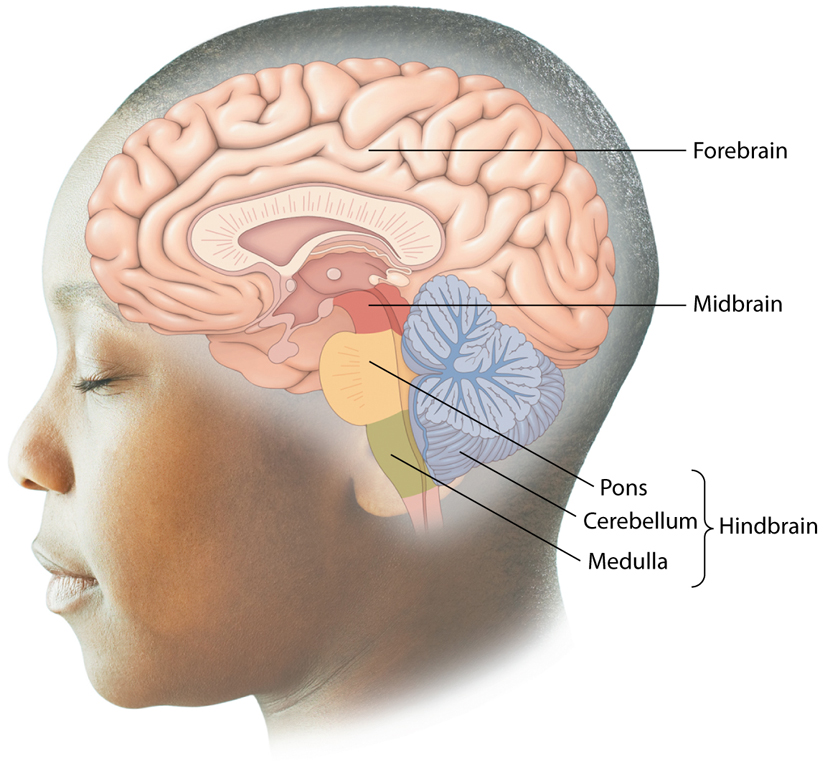The Brain
The brain is the most complex structure of the human body and is responsible for thought, memory, emotion, and language. It weighs about three pounds and is made up of approximately 100 billion neurons. The three major regions of the brain are the hindbrain, the midbrain, and the forebrain.
Hindbrain: The hindbrain is directly connected to the spinal cord and regulates breathing, heart rate, arousal, and basic functions of survival. The hindbrain is made up of the medulla, the pons, and the cerebellum. These three are collectively known as the brain stem. The medulla regulates breathing, heart rate, and blood pressure. The pons relays information from the lower to the higher brain regions. The cerebellum is responsible for body movement, balance, coordination, fine motor skills, and is important in cognitive activities such as language and learning.
Midbrain: Different parts of the midbrain control eye muscles, process both auditory and visual information, and initiate voluntary body movement.
Forebrain: The forebrain is the largest part of the brain made up of the cerebrum, thalamus, limbic system and other structures. Regions of the forebrain control cognitive, sensory, and motor function and regulate temperature, reproduction, eating, sleeping, and expression of emotions. Most forebrain structures are bilateral, located on each side of the brain. Within the forebrain, the thalamus receives input from the senses. All sensory signals go first to a relay station in the thalamus, a central structure named after the Greek word for "couch" because the cerebral hemispheres seem to rest comfortably on it. The thalamus relays sensory impulses to the cortex. The cortex controls thought, decision, memory, and emotional response. About 85 percent of all neurons in the body are in the cortex, also known as the cerebrum or cerebral cortex. The prefrontal cortex oversees thought and logical thinking and has been linked with depression and schizophrenia.
Limbic System: The limbic system is located directly around the thalamus and is important in emotion and motivation. The system includes the hypothalamus, the amygdala, and the cingulated gyrus. The amygdala and the hippocampus help form new memories as well as influence motivation and emotion. Our ability to read the facial expressions of emotion in other people is registered primarily in the limbic system. The hypothalamus regulates almost all major drives including hunger, thirst, temperature, and the sex drive. It also controls the pituitary gland and the production of hormones. Despite its numerous vital functions, the hypothalamus in humans accounts for only 1/300 of total brain weight, and is about the size of an almond. The basal ganglia are a collection of structures surrounding the thalamus and are involved in voluntary motor control. The cingulated gyrus is a belt-like structure which plays an important role in attention and cognitive control.
Cerebrum and Cerebral Cortex: The outer, convoluted layer of the brain is known as the cerebral cortex. A large portion of human thought, planning, perception, and consciousness take place in the cerebral cortex. The cerebrum consists of four lobes. Functions of the frontal lobes include recognizing consequences, attention, planning, abstract thinking, control of impulses, creativity, and social awareness. The parietal lobes play a role in sensation and perception of touch. The temporal lobes house the auditory cortex which controls hearing and they are involved in memory and emotion. Visual information is processed in the visual cortex of the occipital lobes. The insula is located deep inside the cerebrum and is active in the perception of sensations, emotional states, empathy, and addictive behaviors.

return to top | previous page | next page
